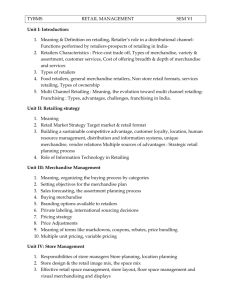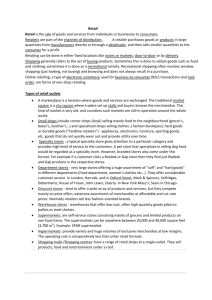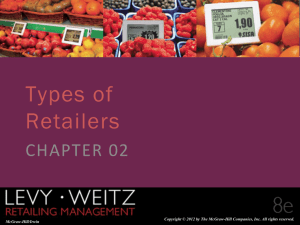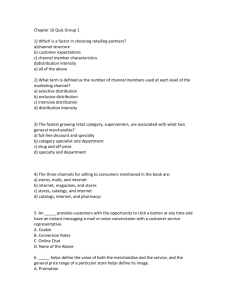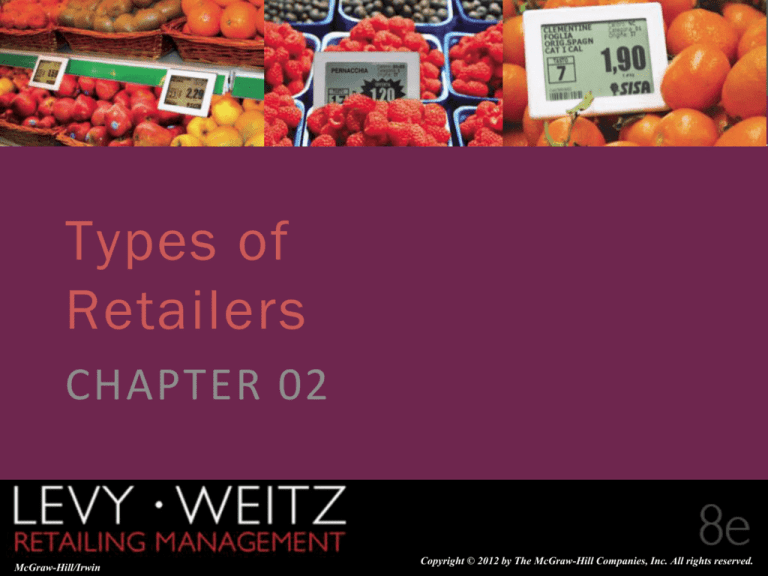
CHAPTER 2
1
Types of
Retailers
CHAPTER 02
Retailing
Management 8e
McGraw-Hill/Irwin
2-1
© 2012
by The McGraw-Hill Companies, Inc. All rights reserved.
© The McGraw-Hill Companies,Copyright
All rights
reserved.
Retailer Characteristics
CHAPTER 2
1
• Variety (breadth)
• Assortment (depth)
• Services Offered
• Prices and the cost of offering breath and depth of
merchandise and services
2-2
Merchandise Offering
CHAPTER 2
1
Variety (breadth of merchandise): wide vs. narrow
- The number of merchandise categories
Assortment (depth of merchandise): deep vs. shallow
-the number of items in a category (SKUs)
2-3
Services Offered
CHAPTER 2
1
• Retailers differ in
the services they
offer customers
• EMS offers assistance
in selecting the
appropriate kayak
and repairing them
VS
• http://www.outdoor
play.com and
• Wal-Mart: doesn’t
provide any services
2-4
Types of Merchandise Retailers
Food Retailers
Mom and Pop Stores
Convenience Stores
Supermarkets
Supercenters
CHAPTER 2
1
General Merchandise Retailers
Department Stores
Specialty Stores
Discount Stores
Category Specialists
Off-Price Retailers
Warehouse Clubs
Value Retailers
2-5
Food Retailers
CHAPTER 2
1
• Channel preference for food shopping channel where
grocery purchasers do most of their food shopping
• Supermarkets
• Supercenters
• Warehouse Clubs
• Convenience Stores
2-6
Supermarkets
CHAPTER 2
1
• Conventional supermarkets
• 30,000 SKU
• Limited assortment supermarkets
(extreme value food retailers)
• 2000 SKU
• Offer one or two brands and sizes
• Designed to maximize efficiency and
reduce costs
• Offer merchandise at 40-60% lower
prices than conventional supermarkets
2-7
Trends in Supermarket Retailing
CHAPTER 2
1
• Competition from Discount Stores
Efficient
Distribution
Lower Costs
Lower Prices
• Changing Consumption Patterns
Time Pressure
Eating Out More
Meal Solutions
2-8
Conventional
Supermarket Survival Pack
CHAPTER 2
1
• Emphasize Fresh Perishables
• Wegmans
Chef-crafted meals on the go at EatZi’s
• Target health conscious and
ethnic consumers
• Offer more private label brands
• Provide a better in-store
experience
2-9
Supercenters and Warehouse Clubs
CHAPTER 2
1
Supercenters (Hypermarkets)
Warehouse Clubs
• The fastest growing retail
category
• Large stores (185,000 square
feet) that combine a supermarket
with a full-line discount store
• One-stop shopping experience
• Offer a limited and irregular
assortment of food and general
merchandise with little service at
low prices
• Use low-locations, inexpensive
store design, little customer
service
• Low inventory holding costs by
carrying a limited assortment of
fast selling items
2-10
Convenience Store
CHAPTER 2
1
• Tailors assortments to local market
• Makes more convenient to shop
• Offers fresh, healthy food
• Fast, casual restaurants
• Financial services available
• Opening smaller stores closer to consumers (like
airports)
2-11
Issues in Department Store Retailing
CHAPTER 2
1
• Competition
• Discount Stores on Price
• Specialty Stores on Service, Depth of
Assortment
• Lower Cost by Reducing Services
• Centralized Cash Wraps
• More Sales
• Customers Wait for Sale
• Focus on Apparel and Soft Home
• Develop Private Labels and Exclusive
Brands
2-12
Three Tiers of Department Stores
CHAPTER 2
1
• First Tier: Upscale, high fashion
chains with exclusive designer
merchandise and excellent
customer service
• Nordstrom, Neiman Marcus, Saks
• Second Tier: Retailers sell more
modestly priced merchandise with
less customer service
• Macy’s
• Third Tier: Value oriented caters
to more price conscious customer
• JCPenney, Sears, Kohl’s
Rob Melnychuk/Getty Images
2-13
Issues in Specialty Store Retailing
CHAPTER 2
1
• Mall-Based Apparel Retailers
• Decline in Mall Shopping and
Apparel Sales
• Lack of New Fashions
• Less Interest in Fashion
• Increased Price Consciousness
• Lifestyle Formats
• Abercrombie and Fitch
• Victoria’s Secrets
• Manufacturers opening their
own stores
McGraw-Hill Companies, Inc./Andrew Resek, Photographer
2-14
Issues in Drug Store Retailing
CHAPTER 2
1
• Consolidation
• Walgreens, CVS, Rite-Aid
• Competition
• Supermarkets, Discount Stores and
Mail-in orders
• Evolution to a New Format
• Stand Alone Sites with Drive Thru
Windows
• Offering more frequent purchase
food items
• Improved systems provide
personalized service
2-15
Category Specialists
• Deep and Narrow
Assortments
• Destination Stores
• Category killers
• Low Price and Service
• Wholesaling to Business
Customers and Retailing
to Consumers
• Incredible Growth
CHAPTER 2
1
Bass Pro Shops
2-16
Issues in Extreme Value Retailing
CHAPTER 2
1
• Focuses on Lower Income Consumers
• Names mostly imply good value not $1 price points
• Low Cost Location
• Limited Services
• One of the Fastest Growing Retail Segments
• Dollar Tree
• Family Dollar
• Dollar General
2-17
Off-Price Retailers
CHAPTER 2
1
• Close-out retailers
• Offer an inconsistent assortment of brand name
merchandise at low prices
• TJX Companies (which operates T.J.Maxx, Marshalls, Winners,
HomeGoods, TKMaxx, AJWright, and HomeSense),
• Ross Stores,
• Burlington Coat Factory,
• Big Lots.
• http://www.Overstock.com and http://www.Bluefly.com
2-18
Services Retailing
CHAPTER 2
1
• Intangibility
• Problems in Evaluating Service Quality
• Performance of Service Provider
• Simultaneous Production and Delivery
• Importance of Service Provider
• Perishability
• No Inventory, Must Fill Capacity
• Inconsistency of the Offering
• Importance of HR Management
2-19
Examples of Service Retailers
CHAPTER 2
1
Type of Service
Service Retail Firms
Airlines
American, Delta, British Airways, Singapore Airways
Automobile maint/repair
Jiffy Lube, Midas, AAMCO
Automobile rental
Hertz, Avis, Budget, Alamo
Banks
Citibank, NCNB, Bank of America
Child care centers
Kindercare, Gymboree
Credit cards
American Express, VISA, Mastercard
Education
University of Florida, Babson College
Entertainment parks
Disney, Universal Studios, Six Flags
Express package delivery
Federal Express, UPS, US Postal Service
Financial services
Merrill Lynch, Dean Witter
Fitness
Jazzercise, Bally’s, Gold’s Gym
Health Care
Humana, HCA
Home maintenance
Chemlawn, MiniMaid, Roto-Rooter
2-20
Merchandise/Service Continuum
CHAPTER 2
1
2-21
Types of Retail Ownership
CHAPTER 2
1
• Independent, Single
Store Establishments
• Wholesale-sponsored
voluntary group
• Corporate Retail
Chains
• Franchises
(c) Brand X Pictures/PunchStock
2-22
Retailers Using
Franchise Business Model
CHAPTER 2
1
2-23
Franchisor Advantages/Disadvantages
CHAPTER 2
1
Advantages
• Rapid expansion, highly motivated franchisees do a good
job, additional profits by selling franchisees products and
services.
Disadvantages
• Company-owned units may be more profitable, less
control then independent retailers over advertising,
pricing, personnel practices, etc.
2-24
Franchisee Advantages/Disadvantages
CHAPTER 2
1
Advantages
• Established/proven product/service, business and
technical assistance, and reduction in risk.
Disadvantages
• Loss of control since only semi-independent, franchisee
outlets may compete with corporate-owned outlets, and
high royalties, fees, costs on equipment, supplies,
merchandise, rental/lease rates and mandatory
participation in promotional and support services.
2-25



